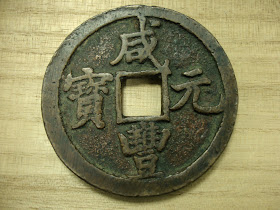

Qing Dynasty Coinage
There were 12 rulers of Qing Dynasty. From the Emperor Nurhachi (努爾哈次) built the Manchu state (which located at North East of China) titled as “Tian Ming” outside the Shanhaiguan Pass(山海關) in Year 1616 to the last Emperor Xuan Tong abdicated in Year 1911. The Qing Dynasty issued coins all long in every reign with varied coinages.
In the initial period before the Shun Zhi reign (the third ruler of Qing Dynasty), the coins coinage were imitated the styles of the former dynasty Ming. After Shun Zhi Emperor entered the Shanhaiguan in 1644, the coin style for one dollar had five versions: the first was with a blank reverse; the second was with a Chinese character on the reverse which showed the name of the mint or the place where the coin was made; the third was made in 1653 (the 10th year of Shun Zhi) with legend “Yi Li” indicating the value in silver; the fourth was issued by Bao Chuan and Bao Yuan mint in 1657(14th year) with the Manchu characters of Bao Chuan and Bao Yuan; the last was made in 1660(17th year) with both Chinese and Manchu characters.
The Emperor Kang Xi (the fourth ruler of Qing Dynasty) had the great achievement in Military activity and people’s livelihood, the Dynasty foundation was laid in this reign for the development of the latter reigns. There are two styles of Kang Xi coins issued by total 21 mints. The coins made by both Bao Chuan and Bao Yuan mint were only with the Manchu characters on the reverse. The coins minted by local mints all had both Manchu and Chinese characters indicating the name of the mint.
In the Uen Zheng reign (the fifth ruler of Qing Dynasty), the coins were made following the late reign with Manchu characters only on the reverse showing the name of the mint and the quantity of Uen Zheng coins was obviously less than that of the former reigns.
Qian Long Emperor (the sixth ruler of Qing Dynasty) issued a huge amount of coins during his reign as long as sixty years with a standard style that there are Manchu characters only on the reverse of a coin indicating the name of its mint. This period Qian Long achieving greatest prosperity of Qing Dynasty, there were 24 mints had issued coins but the quality was gradually reduced in the latter stage.
In Jia Qing period (the seventh ruler of Qing Dynasty), the politics of Qing regime became rotten gradually and the economy was on the decline although the Emperor had done vigorous efforts. So the issuance of coins was just for supporting the routine demand of currency and the quality of the coins was continuously reduced.
Coming to the Dao Guang reign (the eight ruler of Qing Dynasty), the European countries and United State exported a huge amount of opium to China so as to the Qing Dynasty was faced with a financial crisis due to the out flow of a huge amount of money. After the Opium War, the China became a semi-colonial and semi-feudal country.
In early Xian Feng period (the ninth ruler of Qing Dynasty), the Taiping Tianguo rebellion and the Qing Dynasty regime was challenged under the domestic and the foreign troubles. Under this situation, forcing Qing Dynasty had to issue a lot of big-value coins to make up the serious deficit. The various styles of coins by using different metals include copper, iron and lead made the coinage chaotic. In addition, the instructions for the coinage from the government were often changed suddenly within this 10 years. The quantity and the quality of coins were reduced again. The coins circulated in markets were almost not value as it state value on the coins, so as to the people's complaints could be heard everywhere.
In the Tong Zhi period (the tenth ruler of Qing Dynasty), the actual ruler empress Che Xi (the wife of Emperor Xian Feng) monopolized the power and execution the new policy that imitate west country policy. Besides the issuance of Value-ten coins, the quantity and the quality of the one dollar coins were greatly reduced again and many illegal coins with small sizes were circulated together with the legal coins.
In Guang Xu period (the eleventh ruler of Qing Dynasty), the scripts on the coins were varied. This formed the major characteristic of the coinage in the latter stage of Qing Dynasty. Meanwhile in pace with the fast growth of trade with foreign countries, the machine-made silver and copper coins with exquisite patterns appeared. The traditional coins with a square hole were gradually withdrawn from the field of circulation along with the change of the coinage,
In Xuan Tong (the last ruler of Qing Dynasty) only a few old style coins were made in order to maintain the livelihood of the workers in the mint. At that time, the machine-made copper coins completely replaced the traditional coins. The round coin with a square hole circulated for more than 2000 years finally accomplished its historical mission.
To summarize, due to Qing Dynasty special history background, the whole Qing Dynasty coinage no matter what the quantity and the styles of the coins were much more than that of the former Chinese Dynasties. Indeed, it making coin collectors of Qing Dynasty were easy to addict in it. Qing Dynasty coins really were the coin collection paradise that will give collectors full of surprise and emotion experience. Come to joint us and I am sure you will enjoy it!
Learner 2009.05.02
沒有留言:
張貼留言